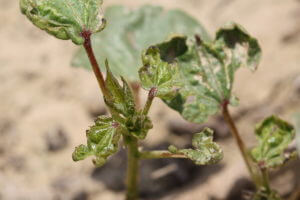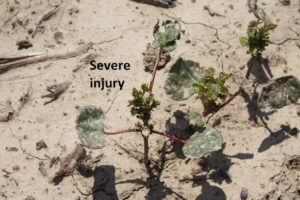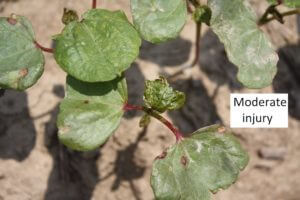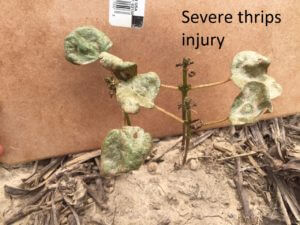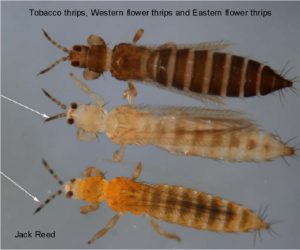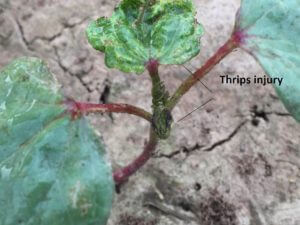Management options
| Insecticide (Trade Names) for THRIPS | Lb Active Ingredient per Acre | Amount Formulation per Acre | Performance Rating Thrips / WFT**** |
|---|---|---|---|
| In-furrow Systemic Sprays or Granular: | |||
| acephate 90 *** | 0.9 - 1 | 1 - 1.1 lb | 7 / 5 |
| aldicarb (AgLogic 15g) | 0.525 - 0.75 | 3.5 - 5 lbs | 8 / 7 |
| imidacloprid (Admire Pro 4.6) | 0.27 - 0.33 | 7.4 - 9.2 oz | 8 / 2 |
| imidacloprid (Velum Total 2.17) | 0.24 - 0.31 | 14 - 18 oz | 8 / 2 |
| Foliar Sprays: * | |||
| acephate 90 *** | 0.25 - 0.5 | 4.4 - 8.9 oz | 6 / 5 |
| acephate 97 (Orthene 97) *** | 0.25 - 0.5 | 4.1 - 8.2 oz | 6 / 5 |
| dicrotophos (Bidrin 8) *** | 0.188 - 0.2 | 3.0 - 3.2 oz | 8 / 5 |
| dimethoate 4 *** | 0.188 - 0.25 | 6 - 8 oz | 6 / 2 |
| spinetoram (Radiant SC 1)** | 0.012 - 0.023 | 1.5 - 3 oz | 8 / 7 |
| spinetoram, methoxyfenozide (Intrepid Edge)** | See Label | 3.0 oz | 8 / 7 |
| Treated Seed: | |||
| imidacloprid (Gaucho 600, Aeris, Acceleron Standard, Acceleron Elite, Avicta Elite Cotton Plus) | 0.34 - 0.375 mg active ingredient per seed | 6 / 2 | |
| Orthene 97 SP or Acephate 80S * *** | Acephate can be applied to a seed at 6.4 oz/100 lb seed (Orthene 97 ST) or 8 oz/100 lb seed (Acephate 80 S) | 5 / 3 |
* Not recommended as a standalone treatment for thrips control.
** Radiant SC is suggested if western flower thrips are present in significant numbers. The use of an adjuvant is recommended when using Radiant SC or Intrepid Edge for control of thrips, although several herbicides that are commonly co-applied with thrips application can act as an adjuvant.
*** Tobacco thrips resistance to organophosphate insecticides is increasing, use with caution.
**** General rating for typical thrips control vs. rating specific for western flower thrips (WFT).
- It is generally best to make any foliar insecticide applications by the second leaf stage. More than one foliar insecticide application is rarely justified.
- A preventative foliar application is often suggested under adverse growing conditions such as cool weather.
